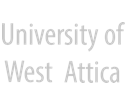Quality Assurance Information System-The Case of the TEI of Athens
Abstract
Keywords
References
Aboubekeur Hamdi-Cherif, (2011) A computational framework for academic accreditation and assessment in higher education (A3-HE): part 1 academic process, AIKED'11 Proceedings of the 10th WSEAS international conference on Artificial intelligence, knowledge engineering and data bases.
Aboubekeur Hamdi-Cherif, (2011) A computational framework for academic accreditation and assessment in higher education (A3-HE): part 2 technologies, AIKED'11 Proceedings of the 10th WSEAS international conference on Artificial intelligence, knowledge engineering and data bases.
BOC, Business Process Management with ADONIS. http://www.bocgroup.com/products/adonis/
Chalaris M., Tsolakidis A., Sgouropoulou C. & Chalaris I. (2011) Developing an Information System for Quality Assurance in Higher Education using the Balanced Scorecard Technique - The case study of TEI-A, PCI 2011, ISBN 978-0-7695-4389-5.DOI 10.1109/ PCI. 2011. 43.
European Association for Quality Assurance in Higher Education. http://www.enqa.eu/
Fayyad U.M., Shapiro G.P. & Smyth P. (1996) From data mining to knowledge discovery: an overview. American Association for Artificial Intelligence Menlo Park, CA, USA 1996, ISBN:0- 262-56097-6
Finch, H. (2005). Comparison of distance measures in cluster analysis with dichotomous data. Journal of Data Science, 3, 85-100
Harkiolakis, N., (2005) An Automated Approach to Assessment Management of Higher Education Institutions, Computer as a Tool, 2005. EUROCON 2005, Belgrade
HQAA, Hellenic Quality Assurance Agency for Higher Education. http://www.hqaa.gr/
Huberty, C. J., Jordan, E. M., & Brandt, W. C. (2005), Cluster analysis in higher education research. In J. C. Smart (Ed.), Higher Education: Handbook of Theory and Research (Vol. 20, pp. 437-457). Great Britain: Springer.
IBM SPSS. http://www-01.ibm.com/software/analytics/spss/
Kettunen, J., & Kantola, I. (2005), Management information system based on the balanced scorecard. Campus-Wide Information Systems, 22, 263–274
Kettunen, J. (2008), A conceptual framework to help evaluate the quality of institutional performance, Quality Assurance in Education, 16(4), 322-332
Power, D. J. (2002), Decision support systems: concepts and resources for managers. Westport, Conn., Quorum Books.
Weka. http://www.cs.waikato.ac.nz/ml/weka/
DOI: 10.18780/jiim.v2i1.3062
Refbacks
- There are currently no refbacks.






